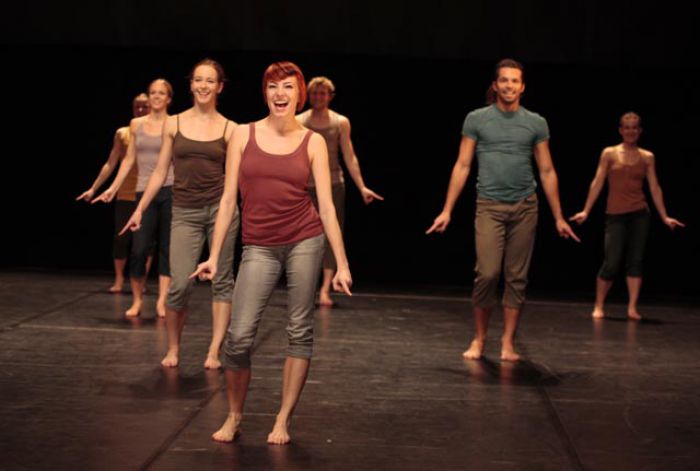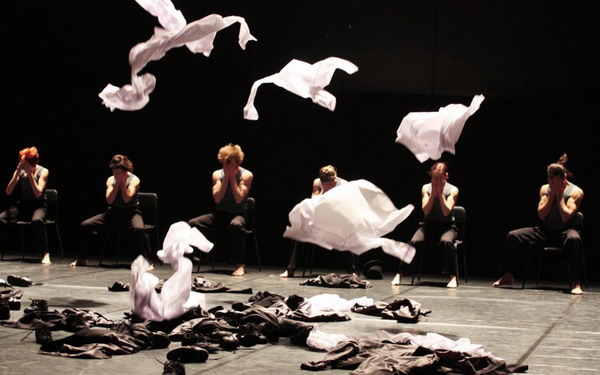Vivat Ohad Naharin, Mr. Choreographer!
 A few days before Christmas, the dance theatre group Polski Teatr Tańca gave their guest performance on the New Stage of the National Theatre; the piece was called Minus 2, a creation by the legendary Israeli choreographer Ohad Naharin. Naharin’s work is associated with the professional Batsheva Dance Company in which he holds the position of artistic director. However, Naharin often lends his choreographic artistry to other companies for which he recycles his previous pieces and the final choreographies are combinations of Naharin’s style and the character and possibilities of the given ensemble.
Minus 2 is a collage of more than ten images, originally danced by the Batsheva Dance Company, and it requires as many as twenty-five dancers. The performance commences when the spectators enter the auditorium. On the stage, a solitary dancer is moving a little bit foolishly, he actually opens the whole piece and stays there for the most of the show time. One by one, the other dancers join him in a negligent choreography. It’s hard to say if this is meant as a part of the opening or just as a way how to play and interact with the audience. Afterwards, a semi-circle of chairs is formed (as a preparation for the famous scene from Kyr, premiering in 1990 - the Czech dance lovers had the possibility to see it within a choreography named Decathlon at Tanec Praha 2004); each dancer occupies one chair and that is where it really starts. Gradually, a game of rhythm and speed develops, each round always ending with a Mexican wave-like movement and with the last dancer in the row dropping to the floor.
This variation runs again and again and speeds up. In every round, the dancers cast off one piece of clothes until they are almost naked. The “dropping one” stays fully dressed as he links the two fragments of the choreography together. Minus 2 is a mixture of delicate movement etudes danced by smaller groups or individuals and of a whole mass of human bodies travelling across the space with clear purpose. Formal passages alternate with informal ones, jeans are replaced with suits. Feminine and masculine principles blend, complete each other or remain unchanged. The theme of love and relationship (in couples or even in love triangles) is also touched upon. The audience can watch a dance at once grotesque and ritualistic - an excerpt from the piece called Black Milk (1985). Male dancers dressed in large culottes lurch in a closed circle and in a while they bespatter their naked chests with mud to express the strong bond with the Mother Earth. Everything seems to happen just by accident but with such confidence and sovereignty that the choreographer’s consistent conceptualisation is more that obvious.
An exciting experience, at least for the “chosen ones“ (those spectators who were wearing black and red on the occasion), came with the song Dance With Me; a fragment from Deca Dance (2000). Each dancer left the stage, selected a dancing partner from the audience, then took them back on the stage for a shared dance, just for the moment and for pleasure. White collar suits contrasting with the black/red outfits and the couples put
A few days before Christmas, the dance theatre group Polski Teatr Tańca gave their guest performance on the New Stage of the National Theatre; the piece was called Minus 2, a creation by the legendary Israeli choreographer Ohad Naharin. Naharin’s work is associated with the professional Batsheva Dance Company in which he holds the position of artistic director. However, Naharin often lends his choreographic artistry to other companies for which he recycles his previous pieces and the final choreographies are combinations of Naharin’s style and the character and possibilities of the given ensemble.
Minus 2 is a collage of more than ten images, originally danced by the Batsheva Dance Company, and it requires as many as twenty-five dancers. The performance commences when the spectators enter the auditorium. On the stage, a solitary dancer is moving a little bit foolishly, he actually opens the whole piece and stays there for the most of the show time. One by one, the other dancers join him in a negligent choreography. It’s hard to say if this is meant as a part of the opening or just as a way how to play and interact with the audience. Afterwards, a semi-circle of chairs is formed (as a preparation for the famous scene from Kyr, premiering in 1990 - the Czech dance lovers had the possibility to see it within a choreography named Decathlon at Tanec Praha 2004); each dancer occupies one chair and that is where it really starts. Gradually, a game of rhythm and speed develops, each round always ending with a Mexican wave-like movement and with the last dancer in the row dropping to the floor.
This variation runs again and again and speeds up. In every round, the dancers cast off one piece of clothes until they are almost naked. The “dropping one” stays fully dressed as he links the two fragments of the choreography together. Minus 2 is a mixture of delicate movement etudes danced by smaller groups or individuals and of a whole mass of human bodies travelling across the space with clear purpose. Formal passages alternate with informal ones, jeans are replaced with suits. Feminine and masculine principles blend, complete each other or remain unchanged. The theme of love and relationship (in couples or even in love triangles) is also touched upon. The audience can watch a dance at once grotesque and ritualistic - an excerpt from the piece called Black Milk (1985). Male dancers dressed in large culottes lurch in a closed circle and in a while they bespatter their naked chests with mud to express the strong bond with the Mother Earth. Everything seems to happen just by accident but with such confidence and sovereignty that the choreographer’s consistent conceptualisation is more that obvious.
An exciting experience, at least for the “chosen ones“ (those spectators who were wearing black and red on the occasion), came with the song Dance With Me; a fragment from Deca Dance (2000). Each dancer left the stage, selected a dancing partner from the audience, then took them back on the stage for a shared dance, just for the moment and for pleasure. White collar suits contrasting with the black/red outfits and the couples put ting all their effort into their numbers - all this offered a range of interesting images and impressions. Timidity gave way to the pure joy of dance - like in the case of Tomáš Sedláček, an economist in red jeans, who was standing in the front row. Or like one of the ladies who received a great applause after having remained in her Batsheva partner’s embrace till the very end. And when suddenly all the dancers hit the floor with the final tones of the song, except for the lady herself, she stood still and waited. The pathos of the unexpected situation penetrated into the audience and rewarded the lady with ecstatic ovations. However, it was the choreographer who deserved the real admiration not only for his creative skills but also for his wit and insight.
The entire piece is not crowned with another rhythmical sequence on chairs, as could be expected, but with an interesting, yet simple, variation of all the dancers. The casual walk of the group, switching of the leaders and giving directions symbolised unity and respect. When the lights went out, many realised only grudgingly that the eye-appealing and touching spectacle was over.
Seeing Naharin’s works performed by Batsheva Dance Company would definitely make the experience even more intense. Polski Teatr Tańca rose well to the occasion, invested enough energy and expression. The technical level was not bad either, even though it wouldn’t be that bright beside the Batsheva.
Vivat Ohad Naharin, Mr. Choreographer! He’s witty, smart and gifted, able to work with emotions and motivation. A great experience for an Advent day.
Written from the performance on 18th December 2013, the only one performance at the New Stage of the National Theatre.
Minus 2
ting all their effort into their numbers - all this offered a range of interesting images and impressions. Timidity gave way to the pure joy of dance - like in the case of Tomáš Sedláček, an economist in red jeans, who was standing in the front row. Or like one of the ladies who received a great applause after having remained in her Batsheva partner’s embrace till the very end. And when suddenly all the dancers hit the floor with the final tones of the song, except for the lady herself, she stood still and waited. The pathos of the unexpected situation penetrated into the audience and rewarded the lady with ecstatic ovations. However, it was the choreographer who deserved the real admiration not only for his creative skills but also for his wit and insight.
The entire piece is not crowned with another rhythmical sequence on chairs, as could be expected, but with an interesting, yet simple, variation of all the dancers. The casual walk of the group, switching of the leaders and giving directions symbolised unity and respect. When the lights went out, many realised only grudgingly that the eye-appealing and touching spectacle was over.
Seeing Naharin’s works performed by Batsheva Dance Company would definitely make the experience even more intense. Polski Teatr Tańca rose well to the occasion, invested enough energy and expression. The technical level was not bad either, even though it wouldn’t be that bright beside the Batsheva.
Vivat Ohad Naharin, Mr. Choreographer! He’s witty, smart and gifted, able to work with emotions and motivation. A great experience for an Advent day.
Written from the performance on 18th December 2013, the only one performance at the New Stage of the National Theatre.
Minus 2 Choreography: Ohad Naharin
Assistant of choreography: Yoshifumi Inao
Costumes: Rakefet Levy
Light design: Avi Yona Bueno
Premiere: 26. 11. 2010 Polski Teatr Tańca was established in 1973 in Potsdam, but until today, it has no stage of its own. It is the oldest dance company in Poland, but performs all around the world. Since 1988, the Artistic Director has been Mrs Eva Wycichowska, who shaped the direction towards modern and contemporary dance and linking other artistic genres with movement. The ensemble expresses itself with a great creativity and aesthetics.


